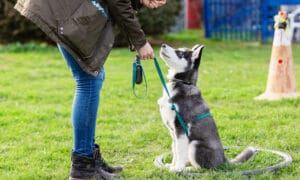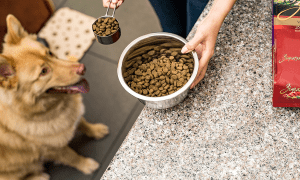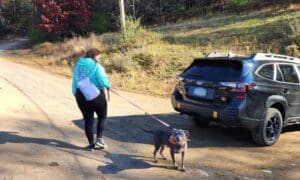“This post contains affiliate links, and I will be compensated if you make a purchase after clicking on my links.”
Have you ever found yourself frustrated that your dog will listen and follow cues easily when inside the home, but the moment you step outside, he seems to forget everything he’s been taught?

“Hi Steve, My dog listens great when I work his obedience in my kitchen and living room, but he doesn’t listen outside. How do I get him to listen?” – Mark M.
Hi Mark,
This is a VERY common struggle for many dog owners. It comes down to two things: A lack of focus and a lack of generalized understanding.
A lack of focus refers to your dog losing engagement and attention on you, because they find the outside stimuli of squirrels, passing people, sights, sounds, etc. more intriguing. The way you improve attention and engagement with your dog, is by becoming the source of super fun things while your dog is outside. Start working your dog in a low distraction outside environment (driveway, back yard, etc.) When your dog pays attention/listens to your command, reward them with high value food rewards or engage them in active game play. Here’s how to play Tug or Fetch your dog.
What do I mean by a lack of generalized understanding? Dogs are naturally contextual learners. They know that “Sit” means, when facing you while in your kitchen. They don’t necessarily know it means to “Sit” next to you at your side while on a walk.
As humans, if someone asked us to ‘have a seat’, we would easily understand to sit in a chair, on a bench, in a hammock, or on a stool. We would also be able to easily ‘have a seat’ inside our house, out on the back patio, or in an office building. We can clearly generalize our understanding of words and phrases. Our dogs cannot. This disparity is what frustrates many owners and confuses most dogs.
So how do you help clarify things for your dog, so they expand their contextual understanding to a general understanding? Simply practice the commands they have already mastered in one setting, in a new setting. You may need to take one step back (by lowering the requirement and helping with a food lure) in order to take two steps forward in progress. Always look to set your dog up for success, by making things easy and building on small wins of success. Here are Tips for Beginner Obedience Commands to help you get started.
Once you have garnered your dog’s focus and engagement in high distraction environments and sufficiently generalized your dog’s understanding of each command, you will have the true reliability you are looking for.
Steven Reid is a Professional Dog Trainer and owner of S.R. Dog Training in Westchester, NY. For more information about S. R. Dog Training, visit www.srdogtraining.com. Please become a fan of Steve on Facebook at www.Facebook.com/SRDogTraining.























Katelyn L
says:I took my puppy from a dog foster home about a year ago. I love him to bits; he has a great personality, and I feel that he loves our family so much. BUT whenever I take him for a walk, we have problems. How do you stop a dog from pulling when walking?
My husband and I were thinking about taking him to ‘doggy school’, but then again, it’s extremely expensive, and the nearest ‘doggy school’ is far away from us. Maybe you have some advice? THANK YOU!!!!
Great advice!
It's just a matter of patience and understanding. We don't really think alike so we must work together to break the communication barrier and try to understand each others wants and needs through constant work and interaction. We must always remember to stay positive and not get needlesly frustrated.
It's good to keep in mind that every dog is an individual and learns at a different pace, just as us humans, so don't get discouraged no matter how long it takes.